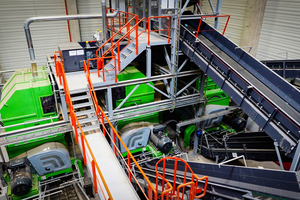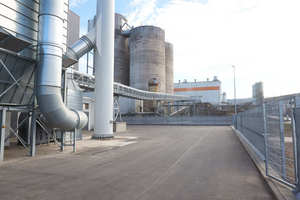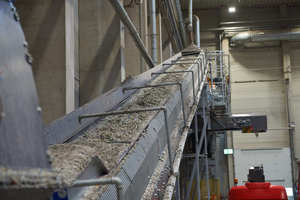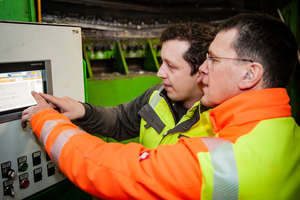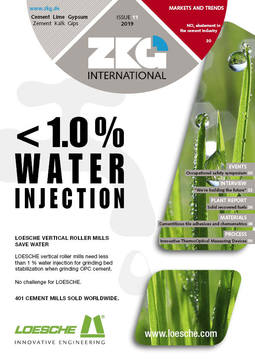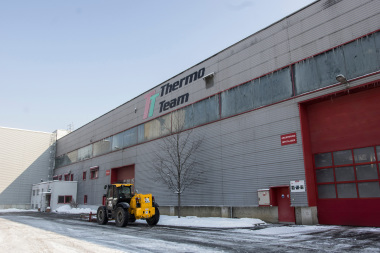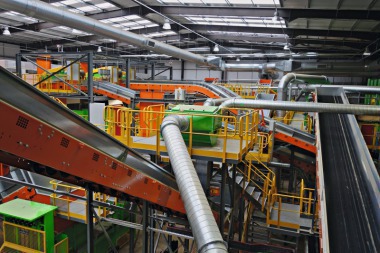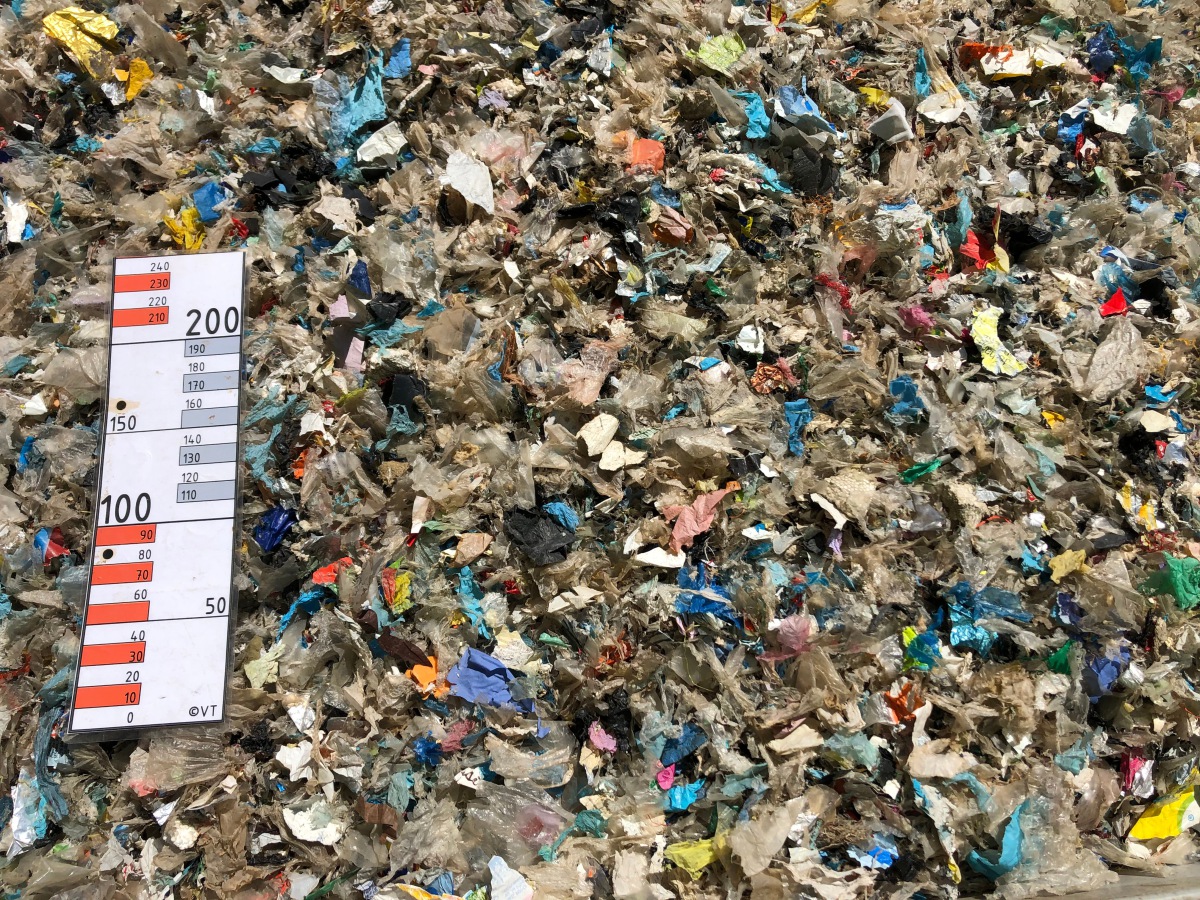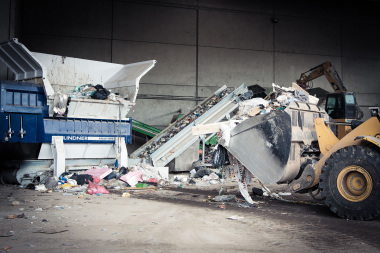Solid recovered fuels for Deuna cement plant
Developed and operated by the B+T Group, a new SRF production facility is located on the premises of Deuna Zement GmbH. The new facility supplies the cement production plant with fuel from sorted and commercial waste in optimum, homogenous quality – 24/7, 365 days a year. One Lindner Jupiter 3200 for primary shredding and three Komet 2800 HP for secondary shredding are in operation there. The latter are part of the new Series 2 – a recently launched Lindner innovation.
Following the ground-breaking ceremony in mid-2017, regular operations could begin at the large facility as early as April 2018 – an incredible team effort by B+T and Lindner that was duly celebrated with a festive inauguration in September 2018.
The challenge: a complete processing line just in time
When installing the shredding and sorting technology, it was of paramount importance to avoid disrupting operations at the adjoining cement plant as much as possible. Since the rotary kilns have to be fed constantly, the best time for the installation was during the overhaul phase, when maintenance and repair work is carried out. An ambitious target that was successfully achieved thanks to systematic planning and perfectly timed implementation.
One of Europe’s most modern plants: the B+T Group’s SRF production facility in Deuna
The Bohn group’s eighth facility – with a total of over twenty Lindner machines in operation – covers an area of 25000 m2 below the cement plant, has a maximum throughput of 250000 t/a and a storage facility for approximately 4000 t of finished goods. Pre-sorted waste is processed at the plant, especially non-recyclable post-consumer packaging and plastic film, as well as rubber and textile waste, which also cannot be mechanically recovered. With the full supply contract, the newly founded operating company B+T Deuna GmbH has agreed to supply the cement plant 24/7, 365 days a year. For quality assurance purposes, the solid recovered fuel is constantly tested for its burning properties using near-infrared technology (NIR). PVC with chlorine has no place in fuel and is safely removed.
Likewise, the calorific value and humidity are permanently monitored. The dosage is adjusted in real time and independently of external laboratories, guaranteeing continuously optimum fuel quality.
However, Deuna has not only invested in modern and high-quality engineering: a tour of the production unit, office and ancillary buildings reveals that the best system technology available has also been used for fire protection, establishing reliable safety standards.
The backbone of the facility: the 420-m-long pipe conveyor
This striking feature enables the premium solid recovered fuels from the SRF production facility to reach their destination in the cement plant: the 420-m-long pipe conveyor connects both facilities and feeds the rotary kilns directly with the solid recovered fuel. It is also the most remarkable architectural element outdoors. ‘The pipe conveyor is visible from afar – and rightly so, because it is the facility’s backbone,’ explains Matthias Pitz, the B+T Group’s CTO. Together with Henning Bruns in the team of experts, he is responsible for the design, planning, construction and monitoring of the Deuna plant.
Innovation starts with the goods’ arrival
Processing at the facility starts with the weighbridge. That is where the B+T Group’s expertise and innovativeness first become evident: the weighbridge and controls are fully automated. Each supplier receives a slip with a barcode to log themselves in at the weighing terminal. Once the cargo’s material and destination have been authorised, the supplier is assigned an unloading space on the premises and is given access. Bale goods account for seventy per cent of all deliveries, while the rest is loose and is brought directly to the ‘input unit’. This is where the material is combined to obtain the perfect SRF product. The ultimate aim is to feed as homogeneous a fuel as possible into the plant, a fuel that has the optimum calorific value for the plant and allows for stable operation – continuously.
Required below, delivered above
The material mixture is prepared for further processing with an environmentally friendly, electrically powered crane grabber. “This is where the primary shredder Jupiter 3200 comes into play,” says Matthias Pitz, explaining the further processing steps. After shredding, the fuel particles are transported to the processing unit, which also houses an optical sorting system. Here, the material is classified using near-infrared devices and wind sifters. Metals and other recyclable materials, which might still be present in the feed material, are removed and sold, while the useful material for SRF production is secondary shredded with the Series 2 Komet 2800 HP.
The fuels are then transferred to the storage area, which Deuna Zement can access via a sophisticated, fully automated system 24/7, 365 days a year, and from where it can request the required quantity of fuel for the rotary kilns at any time of day or night. This system offers the recipient, i.e. the cement plant, the greatest possible flexibility and safety, as the necessary material is requested autonomously: “It’s the cement plant itself that controls the material flow from the storage area into our receiving container, which is installed right next to the rotary kilns,” explains Operations Manager Ronny Hanstein. “As soon as material is removed from the storage area, it is automatically restocked by the crane. It has to overcome a difference in height of approximately 35 m,” Hanstein continues: “so when material is needed down here, we deliver it up there.” With this system, up to 30 t of solid recovered fuels can be transported per hour.
Jointly developed: the new Komet Series 2
The Lindner facility components play a vital role in the Bohn group’s consistently high SRF quality. Matthias Pitz explains the advantages of the Lindner machines: “In our experience, the Komet secondary shredders are machines that operate reliably 24/7 and always produce the perfect output material, i.e. the desired quality in the required quantity.” At the new plant in Deuna, the B+T Group is now using the optimised Komet Series 2 for the first time. Many improvements to this new machine series are the result of feedback from Lindner’s long-standing client. “The input and practical experience of the B+T Group, which is known in the industry as a fine-tuner, out-of-the-box thinker and pioneer, are highly appreciated and have had a considerable impact on the further development of our shredders,” confirms Stefan Scheiflinger-Ehrenwerth, Product Manager at Lindner.
According to Scheiflinger-Ehrenwerth, the crucial secondary shredder improvements implemented by the Austrian shredder specialist after a joint innovation workshop are: exchangeable wear plates, simplified access to machine components for maintenance and repairs, a new generation of frequency converters, anti-vibration electrical cables and optional versions for special applications.
The essentials: productivity and reliability
The combination of powerful motors, resistant belt drive and robust components in the Lindner shredders have proven their worth time and again and guarantee smooth operation with minimum downtimes. Matthias Pitz particularly appreciates the Lindner shredders’ resistance to non-shreddables. That’s very important since waste contains more problematic substances now than ever before. One reason is consumers’ waste separation behaviour which leaves much to be desired, as a study by the University of Leoben in Austria shows. For example, sizeable metal parts can be found in plastic waste, and organic waste is disposed of in the general rubbish bin or in waste paper bins.
To safely separate this material and turn it into high-quality fuels, a considerable amount of engineering technology is required that Lindner and Bohn provide together.
“Lindner’s robust shredders are made for difficult material flows containing non-shreddables and foreign parts,” confirms Matthias Pitz. And if anything does get stuck, the hydraulically operated, inward-opening maintenance door allows for safe maintenance access to the cutting chamber and the quick removal of non-shreddables. The cutting gap between the counter knives and the shaft knives in the Komet Series 2 can even be adjusted during machine operation. The benefits are obvious, as Stefan Scheiflinger-Ehrenwerth explains: “By adjusting the cutting gap, you can counteract the natural wear and tear on the knives, meaning that they have a longer service life and the high quality of the output can be maintained for a very long time.”
Reliable operation 365 days a year
Production at the Deuna cement plant takes place in shifts – 24/7, 365 days a year. Which means that the supplier of the solid recovered fuels has to deliver non-stop, too. To avoid potential faults and hence downtimes wherever possible or to fix them without delay, Lindner offers a special analysis tool for rapid diagnostics and troubleshooting that enables visualisation on the machine itself and detailed monitoring of all processes. The touch panel displays error messages clearly and concisely, meaning that faults and defects can be localised immediately and promptly repaired. “With this transparent visualisation the user has a complete overview of absolutely everything”: Matthias Pitz is full of praise for this well-engineered system that is extremely user-friendly too since it not only monitors but also identifies optimisation potential that can mostly be implemented straight away and does not require any special expertise.
//www.lindner.com" target="_blank" >www.lindner.com:www.lindner.com | //www.bt-umwelt.de" target="_blank" >www.bt-umwelt.de:www.bt-umwelt.de

